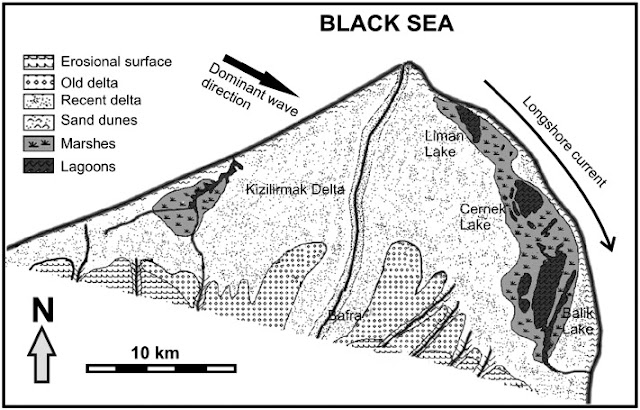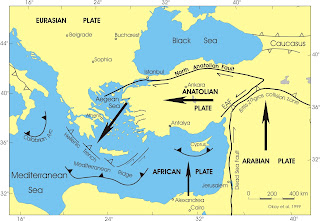Turkey Reduces Wildfire Losses by 80%
Like much of the
rest of the world subjected to a changing environment and rapid urbanization,
wildfires have been steadily increasing.
For example, more than 620,000 acres of forest land burned in 1,132 fires during 2017
alone when forest lands were turned into ashes because of different fires which
occurred in the western province of İzmir.
Both human and wildlife lives were lost and local forestry ministers estimate it will take 10 years or more for a new ecosystem and forest to form.
Fires also burned
in Turkey in the Mediterranean and Aegean provinces of Muğla, Antalya and
Denizli in 2017, as well as the eastern province of Erzurum and the capital of Ankara.
This satellite image was collected
by the Moderate Resolution Imaging Spectroradiometer (MODIS) on the NASA Aqua
satellite on July 3, 2017. Actively
burning areas, detected by MODIS’s thermal bands appear in red.
According to the 2016
statistics, only 10 percent of the forest land fires were caused by natural
factors such as heat or a lightning bolt while 90 percent were manmade. Fifty-four percent of the manmade fires were
unknown, while 31 percent were causes by negligence and 5 percent determined as
deliberate. As noted numerous
times in Keller and DeVecchio’s Natural Hazards, “Humans can turn disastrous events into catastrophes.”
Turkey
has embarked upon an effort to combat the problem including prevention, reclamation
of burned areas to prevent future wildfires and more effective response to
wildfires once started. A key part of this latter effort was to respond
to fires as soon as they start, to more quickly to reduce their damage.
To do this, the Turkish government explored automated methods of wildfire
detection to decrease response times, lower monitoring costs and help determine
location, intensity and direction of the fire more accurately.
Expanding
Turkey’s Wildfire Response
Turkey’s analysis found that for every second of time lost in putting firefighting resources in direct contact with fire sites, the fire spreads on an ever-increasing scale. Research indicated the first 15 to 20 minutes of a fire’s starting was the most important response period to limit damage. Depending upon traditional detection and reporting means which included a network of fire spotting stations, public safety officers (such as natural resources officers and employees) and citizen reporting was found to be one of the critical paths not responding fast enough.
Turkey’s analysis found that for every second of time lost in putting firefighting resources in direct contact with fire sites, the fire spreads on an ever-increasing scale. Research indicated the first 15 to 20 minutes of a fire’s starting was the most important response period to limit damage. Depending upon traditional detection and reporting means which included a network of fire spotting stations, public safety officers (such as natural resources officers and employees) and citizen reporting was found to be one of the critical paths not responding fast enough.
They reviewed new technologies in
communication and also the ability to recognize the visual “patterns generated
by wildfire, specifically the smoke and the flame itself.
They embarked upon what would become the most
effective and rapid intervention in the country’s history, what eventually
became known as the “Forest Fire Early Warning System,” a project implemented
in 2007.
Like much of the rest of the world subjected to a changing environment and rapid urbanization, Turkey’s wildfires have been steadily increasing. Turkey’s areas of concern are along the country’s Mediterranean ocean coastal strip, which covers 30 million acres, or about 60% of the country's forest area.
Adopting A More Effective Wildfire Strategy
Turkish officials worked with a research group to design and launch a network of high performance security cameras mounted on towers or other available locations, with a line of sight across the areas to be protected. The plan feeds visual output into complex analytical software that detects foreground images of flames and smoke against varying background conditions including bright sunlight, night sky, clouds and fog.
This successful pilot effort resulted in being able to detect early fires within a radius of
~9-12.5 miles from the tower's location within
15-25 seconds.
Pattern recognition software was used to
process images and distinguish target elements such as normal colors and
patterns like vegetation that occurred in the wildland area. The resulting
digital images were transferred via wireless networks from the towers to a
monitoring center many miles away in Turkey’s urban areas. While the
high-resolution images could be monitored directly, control software was later
added which allowed non-human monitoring and alarms to be issued automatically
if a fire was detected. This resulted in better firefighting asset location and
deployment and more accurate and timely dispatching methods.
The initial pilot consisted of only five
cameras mounted on three detection towers monitoring a total of 210,000 acres
of forest land. In the first period of operation, these cameras were able to
detect 100% of the fires which occurred naturally in these areas within a 30
second window. Based upon this success, over the next five years, the number of
cameras was increased to over 150. This resulted in a perfect record of
detection of nearly 250 fires, while reducing the average detection time to 15
seconds.
Based on these results, Turkey has its “Forest
Fire Early Warning System" in more areas vulnerable to forest fires. One
of the key benefits has been to prevent new fires in fragile areas recovering
from previous burns. They have also added infrared imaging as a post
suppression strategy to prevent flare ups in areas that have just gone through
fire suppression efforts.
This program has helped Turkey better protect
their forested resources within their fire containment resource pool than just
about any other nation within the European Union. Officials hope their case can also serve as an
international model for more effective conservation of forests as a source of
biological diversity, the fight against climate change, and maintaining clean
air and water resources.
REFERENCES
REFERENCES
Keller & DeVecchio, Natural Hazards, 2015





Comments
Post a Comment